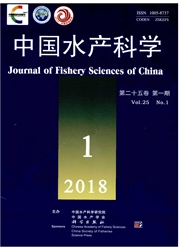

 中文摘要:
中文摘要:
于2012年5月至2013年11月,对池养中华绒螯蟹(Eriocheir sinensis)全程投喂配合饲料,观测扣蟹和成蟹阶段的生长规律、成活率、早熟率、性腺发育速度、产量、规格分布和饲料系数等。结果表明:(1)扣蟹阶段雌雄生长差异不显著(P〉0.05),增重率(WG)和特定增长率(SGR)为先上升后下降,整个扣蟹培育阶段的平均SGR为1.9%/d左右;平均成活率和早熟率分别为10.0%和4.9%,雌体的早熟率显著高于雄体(P〈0.05);一龄早熟蟹和正常扣蟹的平均体重分别为19.8 g和7.5 g左右,一龄早熟蟹和正常扣蟹的平均产量分别为229 kg/hm^2和2433 kg/hm^2;扣蟹培育阶段饲料投喂主要发生在7—10月,占全部饲料用量的80%以上,饲料投喂量与扣蟹体重及池塘水温具有一定的关系,扣蟹阶段饲料系数(FCR)为2.15。(2)成蟹养殖过程中,自6月份起雄体体重大于雌体,整个养殖阶段雄体的SGR显著高于雌体(P〈0.05);雌雄成蟹最终平均体重分别为126.1 g和181.1 g,雌、雄及总体成活率分别为61.30%、53.47%和58.4%,产量分别为412.20 kg/hm^2、536.10 kg/hm^2和950 kg/hm^2;成蟹养殖的饲料消耗主要发生在7—10月,其中育肥前期(9—11月)的饲料用量占50%左右,整个成蟹养殖阶段的FCR为2.63。(3)池养成蟹的生殖蜕壳主要发生在8—9月,雌体比雄体早20 d左右;雌体的性腺发育主要发生在生殖蜕壳后的9—10月,雄体的性腺发育时间跨度较长,生殖蜕壳前性腺指数已达0.8%左右;雌雄成蟹性腺发育期间肝胰腺指数均呈下降趋势。综上,全程投喂配合饲料能保证池养中华绒螯蟹的正常生长发育,可大规模推广应用于中华绒螯蟹养殖产业。
 英文摘要:
英文摘要:
Formulated diets are an important factor in the sustainable development of Eriocheir sinensis aquaculture. However, no information is available on the growth performance or gonadal development ofE. sinensis based on the formulated diets they are fed in pond culture. Therefore, in this study, we investigated the growth performance, survival, precocity rate of first-year crabs, gonadal development of second-year crabs, crab yield, size distribution, and feed conversion rate (FCR) orE. sinensis during the first and second years of pond culture when fed formulated diets. (1) During the whole juvenile crab culture stage (first year), no significant difference was de- tected in the growth performance of males and females, the average specific growth rate (SGR) was about 1.9%/d, and growth was rapid from June to September; the mean survival and precocity rates were around 10.0% and 4.9%, respectively, and females had significantly higher precocity rates than males; at the end of the first year of culture, the bodyweights of the precocious crabs and normal juveniles were around 19.8 g and 7.5 g, respectively, whereas the average yields of precocious crabs and normal juveniles were 229 kg/hm2 and 2433 kg/hm2, respectively; dietary consumption mainly occurred between July and October, which accounted for more than 80% of the total feed consumption, and the feed consumption was related to the crab biomass and water temperature; FCR was around 2.15 for the whole juvenile culture period. (2) During the whole adult crab culture stage (second year), the average SGRs of the female and male crabs were about 1.6%/d and 1.4%/d, respectively, and the males grew faster than the females after June; the final mean body weights of the adult males and females were around 126 g and 181 g, respectively; the survival rates of the females and males were 61.30% and 53.47%, respectively, and the overall survival was 58.4%, whereas the yields were around 412.20 kg/hm2 (females), 536.10 kg/hm2 (males), and 950 kg/
 同期刊论文项目
同期刊论文项目
 同项目期刊论文
同项目期刊论文
 期刊信息
期刊信息
